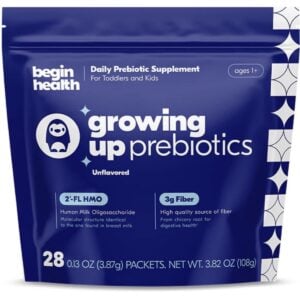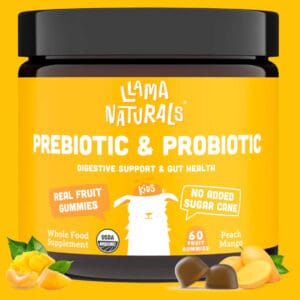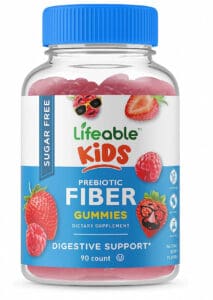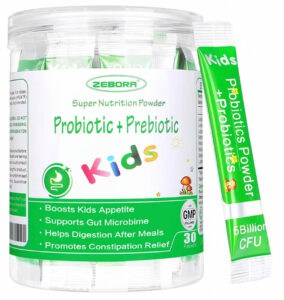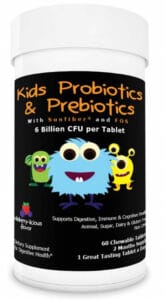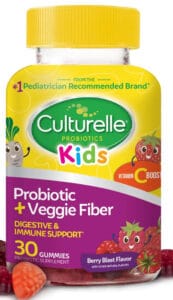Health
Best Prebiotics For Kids (2024)

This post may contain affiliate links. As an Amazon Associate, I earn from qualifying purchases. Please read my disclosure.
If you are looking for the best prebiotics for kids, you have come to the right place! In this post you can learn about why prebiotics are important and beneficial to supporting a healthy gut microbiome. You will find a helpful breakdown of my top picks for pre and probiotics for kids, along with pros and cons, price comparison, and key ingredients! Keep reading to learn if prebiotics might be the right fit for your child, the role they play in supporting healthy children, and which brands to buy.
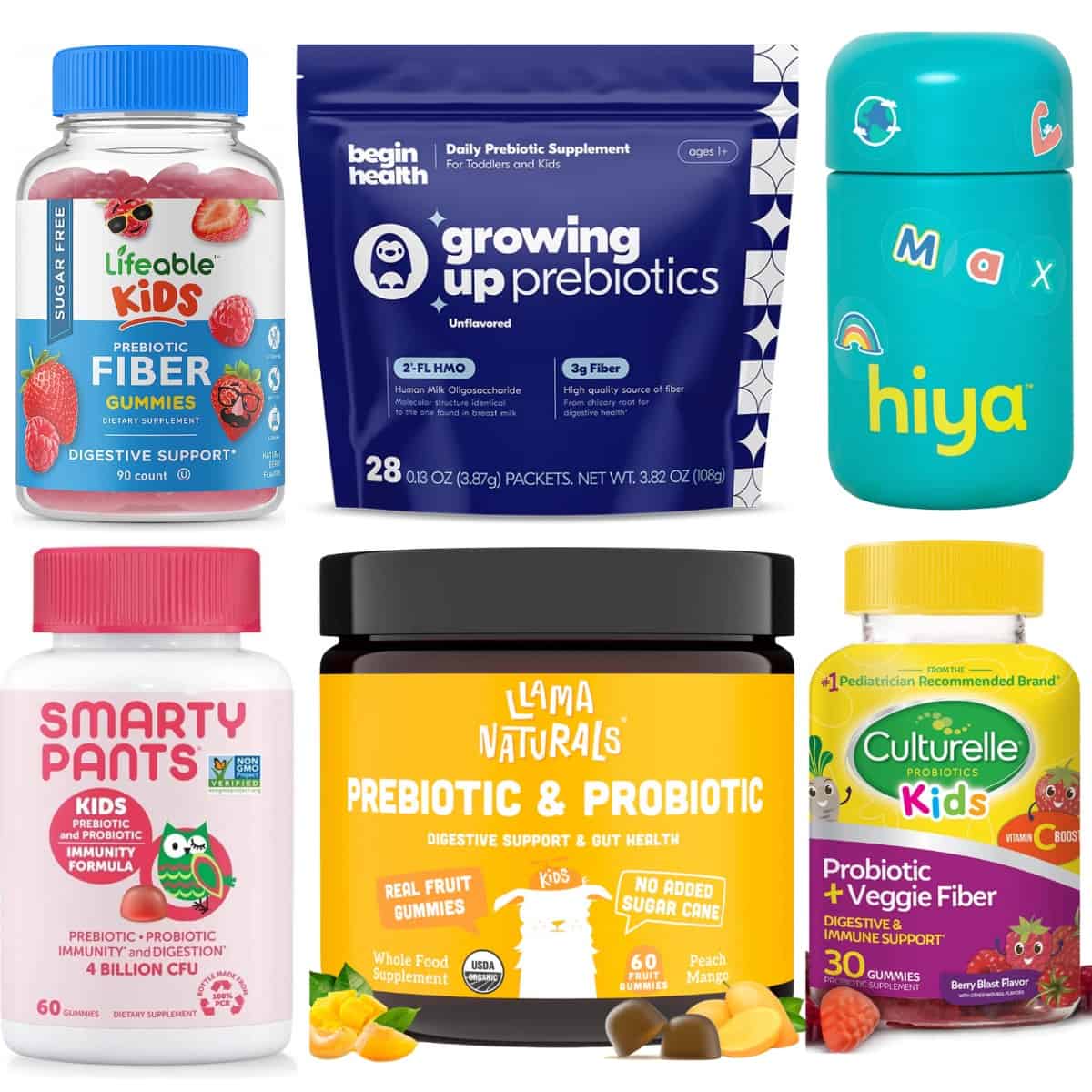

Our Methodology And A Disclaimer
As a board certified health coach and certified nutritionist, I support supplements that are rooted in science and are evidence-based. The FDA does not review dietary supplements for safety and effectiveness before they go to market, so I prioritize products that are third-party tested and certified by one of three independent third-party certifiers (USP, NSF, or ConsumerLab.com). This post has also been medically reviewed and fact checked by Christina Badaracco, MPH, RDN, LDN (see my about page for more info about Christina).
Though I may receive a commission (at no extra expense to you) if you purchase through some of the affiliate links provided, I only recommend products I’ve researched, evaluated, consulted experts on, and would feel comfortable giving to my own two children. As always, I only share products that are the highest quality and that can help you and your family the most. By purchasing any of these products from the links below, you help keep this blog running, so thanks for your support!
The information shared in this post is not a substitute for professional medical advice, diagnosis, or treatment. Never disregard or delay in seeking professional medical advice because of something you read here and always consult with your doctor to determine the proper administration and recommended dosage of supplements for your child.
The Gut Microbiome
The gut microbiome consists of the genetic material of the ecosystem of microbes that reside in the digestive tract – including the stomach, small intestines, and large intestines. The microbiota consists of trillions of live microorganisms such as bacteria, fungi, and parasites. These microbes may float around or attach to the gut lining, and can play a critical role in regulating the function and health of the host. The relationships are often symbiotic and can be beneficial to both the human and microorganism.
One of their most important roles is to support digestive function. They break down some components of food and can use them to produce beneficial nutrients for the body. This complex microbial ecosystem also plays a key role in functions of the immune system, cognition, respiration, the heart, and other areas
It’s important to maintain a proper balance within the gut microbiota for optimal health. Many factors can impact this balance, such as lack of certain foods or nutrient diversity, chronic stress, and antibiotic usage. The imbalance can lead to the bad microbes taking over, causing more susceptibility to illness, improper digestion, malabsorption of nutrients, and bowel issues.
What Are Prebiotics?
Prebiotics are a special type of substance in our diets that cannot be digested by the body but still impart health benefits (e.g. certain plant fibers) (source). Instead, the fibers or other substances serve as food for our gut bacteria, allowing them to grow and flourish within the gastrointestinal (GI) tract.
Supporting the “good guys” can help maintain or bring the gut back to proper balance so that the body can function effectively. While some people can naturally get all the fiber and other prebiotics needed through their diet, others may benefit from changing their diets and/or adding prebiotic dietary supplements! Gut health is so important for everyone, but young children are often overlooked.
How Are Prebiotics Different From Probiotics?
Probiotics are the live cultures of beneficial bacteria that serve to boost populations in the gut. Some people can benefit from supplementing with probiotics while others already have a proper balance of this bacteria in their GI tract through a diverse and healthy diet (among other genetic and lifestyle factors). Prebiotics are not to be confused as another type of live bacteria—rather, they are simply food for the “good guys” in the gut. (Source).
Why Do We Need Both?
Our body relies on beneficial bacteria, as they play a critical role in our digestion, immunity, and more. While it can be helpful to boost the body’s population with the use of probiotics, they also need prebiotics in order to survive. If you or your child does not naturally get a lot of fiber in your diet, it may help to take a prebiotic supplement. Just as you require healthy food, so do these strains of bacteria! We need both in order to maintain a healthy, balanced gut.
How Do I Know If My Child Needs A Prebiotic Supplement?
It is best to chat with your child’s pediatrician before beginning your little one on a prebiotic supplement, but there are a few obvious indicators. If your kid is a picky or selective eater, they are likely not consuming enough fiber on their own. Additionally, if your child has had to take a course of antibiotics, adding both prebiotics and probiotics could help to successfully repopulate healthy bacteria into their gut.
Other signs your child needs prebiotics include digestive issues, irregularity with bowel movements, and complaints about stomach aches. Your child should have well-formed stools on a daily basis, 1–3 times per day (source). There should not be any straining or discomfort when they go potty, and stool should be soft and smooth. Again, talk with your pediatrician, specialist, and/or registered dietitian nutritionist (RDN) about these indications so you can determine whether a supplement is appropriate and if so, the optimal composition and dosage.
Ingredients To Look For In Prebiotics For Kids
It’s best to find a simple prebiotic with minimal ingredients, preferably organic, and no artificial ingredients (or minimal additives). I love that Begin Health has just 2 ingredients – chicory root and human milk oligosaccharide. Each prebiotic supplement may use different prebiotics – for example, Begin Health uses HMOs, but Hiya uses larch tree fiber.
In addition to the actual prebiotic fiber, you want to look for other organic or non-GMO ingredients. The addition of fruits for natural flavor and coloring is great for gummies! To help correct other potential deficiencies, you can look for supplements with added vitamins and minerals such as vitamin D and vitamin C. Note: If your child has irritable bowel syndrome, you may want to consult your child’s pediatrician to figure out which prebiotic may work best.
Ingredients To Avoid
Avoid prebiotics that contain artificial sweeteners and added natural sugar. It really is unnecessary for a prebiotic, which can simply be just fiber alone in powder form! In addition, try to avoid artificial flavors and coloring, along with unnecessary filler ingredients. Begin Health and Hiya offer the best choices for a safe ingredient list, where you’ll also avoid most concerns for food allergies.
Best Prebiotics For Kids
Begin Health
Begin Health offers their Growing Up Prebiotics, a daily prebiotic supplement for kids with just 2 simple ingredients. This prebiotic provides a simple solution for getting more fiber into your child’s diet, allowing for digestive system support and healthy bowel movements. It comes in individual packets for convenient use. It also happens to be the only prebiotic you can use for kids as young as 1! (All of the others on our list below are for kids age 3-4 for the most part!)
The tasteless powder makes for an easy way to sneak this supplement into food, or even just warm or cool water. A big highlight for this prebiotic is that children 1 year old and up can take it! This offers much more availability compared to others on the market that are targeted for older children. You can use this as a prebiotic for baby, toddler, and on! (Learn More: Begin Health Review).
Ingredients Overview: Begin Health prebiotics contain just 2 ingredients: Human milk oligosaccharide (HMO) and chicory root fiber! HMOs are a prebiotic found in breast milk, which has been shown to have benefits for the immune system and intestinal microbiota in babies and kids (source).
Cost: $39 for a one time purchase or $33.15 for a subscribe & save deal (contains 28 servings)
What Customers Say:
“This has been the most amazing product. I was giving my daughter miralax and miners oil daily and she would still go days without pooping. 3 days after starting Begin I took her off both other products and now she goes everyday. It’s been over a year and I still give it to her and my son everyday.” (Source: From reviews on Begin Health’s website).
Tasteless and textureless
Suitable for ages 1 and up
Contains 3 grams of fiber per serving
Promotes easier bowel movements and regularity
Contains 2′-FL HMO, identical to the prebiotics found in breast milk
Gluten-free, nut-free, and egg-free
Easily mixes into drinks and soft foods
Offers convenient subscription options
Can experience some initial bloating or gas (this is normal with any prebiotic)
Hiya Pre + Probiotic
Hiya’s Kids Daily Probiotic offers a blend of both prebiotic fiber and probiotics, promoting healthy bowel movements and digestion. This one-a-day supplement is designed specifically for kids in chewable tablets. There are no gummy additives or added sugars making them one of the best combined pre + probiotics for kids!
Ingredients Overview: Includes probiotic strains Lactobacillus rhamnosus gg, Lactobacillus paracasei, and Bacillus lactis. The prebiotic is sourced from larch tree fiber.
Cost: $30 per bottle (currently 50% off your first order, contains 30 servings)
What Customers Say:
“Very happy with the way this has got things moving. I love that I don’t have to look up the ingredients, and my kids actually consume them.” (From reviews on Hiya’s website)
No refrigeration required
Designed with picky eaters in mind
Convenient subscription service
Does not specify amount of fiber included per serving
Can only be used for kids age 4+ (not suitable for kids aged 1-3)
Contains xylitol (a sugar alcohol)
Llama Naturals Prebiotic & Probiotic
Llama Naturals prebiotic and probiotic gummies are made for kids 2 years old and up. They are clinically proven to help with stomach aches, constipation, and overall gut health (Source: Llama Naturals website). These gummies are certified organic and naturally sweetened and colored with fruit. If you’re wanting something organic, these may be the right probiotics for you! I especially like this prebiotic for toddlers with a selective taste preference, since these have a yummy strawberry flavor.
Ingredients Overview: Includes a blend of probiotics (including bacillus coagulans) and 500mg of prebiotic fiber (xylooligosaccharides).
Cost: $24.95 per jar, or subscribe and save 10% (contains 30 servings)
What Customers Say:
“The kids probiotic gummies were recommended by my sons naturopath doctor. They have made a huge difference in his health. No more constipation and stronger immune system! He loves the taste and asks for them every morning.” (Source: Llama Naturals reviews on their website).
Designed to help stomach aches, constipation, & overall gut health
No artificial ingredients
No refrigeration required
Offers money back guarantee
Can be used for kids age 2+
They partner with RePurpose Certified to recover more plastic waste than they create (as promoted on their site)
Includes unspecified “organic flavor”
Fruit sugars can contribute to cavities (make sure to brush teeth after)
Contains less than 1 gram of prebiotic fiber
Lifeable Kids Sugar Free Prebiotic
Lifeable Kids Prebiotic Fiber Gummies offer digestive support with a natural berry flavor. These sugar free gummies are suitable for kids ages 2 and up.
Ingredients Overview: Includes 4g of fiber per serving! You’ll find chicory root fiber, pectin, and agar agar in these gummy prebiotics for kids.
Cost: $18.52 per bottle (90 count, 45 servings)
What Customers Say:
“These work, and I don’t have to fight with my son to eat them. He doesn’t have trouble going to the bathroom much anymore and actually asks for these if I forget.” (From customer reviews on Amazon).
More affordable than others on the list (per gummy)
Contains 4 grams of prebiotic fiber per serving
Includes unspecified “natural flavors”
Can only be used for kids aged 4+
Zebora Prebiotic + Probiotic
Zebora Kid’s prebiotic and probiotic powder is suitable for 3 year olds and up. It uses quite a few different strains of bacteria, which makes it stand out from the others. This is another good option for prebiotics for toddler constipation and gut health.
Ingredients Overview: This toddler prebiotic and probiotic contains strains such as l. reuteri and lactobacillus casei, along with prebiotic inulin, polyglucose, resistant dextrin, and other ingredients. Note: This product does contain milk, so keep that in mind if your child is vegan, lactose-intolerant, or has a dairy allergy.
Cost: $15.89 per bottle (30 servings)
What Customers Say:
“We searched plenty of pre and probiotics for our little one and agreed to try this one due to the ingredients. It helped keep our little one regular and with it not having a taste, our little one is able to drink it with no problems. Highly recommend!” (From customer reviews on Amazon).
Flavored with natural orange extract
Contains 8 selected probiotic strains
Convenient powder can be added to food and drinks
95% survivability rate for probiotics
Can be used for kids aged 3+
Contains a very low dose of prebiotics (200mg per serving)
Intelligent Labs Pro + Prebiotic
These Kids Probiotics & Prebiotics are made with specific strains of friendly bacteria that can survive in stomach acid and bile, so you know they are making their way to the gut alive! These chewable probiotics are intended to support your child’s gut health and reduce gastrointestinal issues.
Ingredients Overview: These kids prebiotics include a proprietary blend of probiotics, along with guar fiber and fructooligosaccharides to promote a healthy gut microbiota.
Cost: $19.94 per bottle (60 servings)
What Customers Say:
“Bought this for my son who is continuously having tummy issues. This has helped immensely with the problems we were having and I will buy again.” (From customer reviews on Amazon).
No refrigeration required
Unclear how much fiber is in each serving
Contains xylitol, silicone dioxide, and stevia (not necessarily bad, but might not be preferred)
Includes unspecified “natural flavors”
Smarty Pants Gut + Immune Health
SmartyPants Kids Prebiotic and Probiotic gummies are designed to offer digestive and immune support for children 3 and up. They are naturally microencapsulated to ensure a 95% survival rate reaching your little one’s gut.
Ingredients Overview: These children’s probiotics include two strains of probiotics and prebiotic beta-glucan as well as organic sugar and some other ingredients.
Cost: $25.99 per bottle (30 servings – 2 servings per day / 60 count per bottle)
What Customers Say:
“These work Amazing for my Little one. They are the only ones I have found to help build her immune system up and keep it up!” (From customer reviews on Amazon).
Non-GMO, and many ingredients are organic
No artificial flavor, colors, or sweeteners
No refrigeration required
95% survivability rate for probiotics
Gluten and Top 8 allergen free
Clean Label Project-certified
Contains added sugars and corn starch
Includes unspecified “natural flavors”
Can only be used for kids age 4+
Culturelle Kids Pre + Probiotics
Culturelle Probiotics for kids is suitable for children 3 years and up, offering probiotics, prebiotics, and vitamin C! This is a good option if you are looking for a little extra immune support.
Ingredients Overview: These gummy probiotics include bacillus subtilis and bacillus coagulans, along with prebiotic chicory root fiber and vitamin C (ascorbic acid).
Cost: $13.13 per bottle (30 servings)
What Customers Say:
“My kids think they taste good and they keep him regular. Has been taking them daily for over a year.” (From customer reviews on Amazon).
#1 Pediatrician recommended brand
Naturally colored from fruit and veggies
Includes vitamin C for additional immune support
Can be used for kids age 3+
Contains less than 1 gram of prebiotic fiber
Includes unspecified “natural flavors”
What Are Good Food Sources Of Prebiotics For Kids?
In addition to supplementing, there are also foods containing prebiotics that can be added to your child’s diet. The top 5 prebiotic-containing foods include onions, garlic, Jerusalem artichoke, dandelion greens, and leeks (source). These have the highest amount of prebiotic fibers within them. However, other prebiotic foods may be more kid-friendly, such as bananas (ideally slightly green), potatoes, kiwi, oats, chicory root, and asparagus. You can allow potatoes to cool first to form resistant starch (which is not digested and can instead be broken down by bacteria) and then they can be reheated (source).
Do Prebiotics Have Side Effects?
Side effects of prebiotics should not impact your child long term. Your child may initially experience some common issues such as mild abdominal pain from gas and bloating during the first week. This is normal when introducing new fiber supplements for toddlers and adults alike (source). You may want to talk to your pediatrician about starting with a lower dose and increase a little bit every few days. This will minimize any potential problematic symptoms and help your child’s gut adjust to the additional fiber.
Who Should Not Take Prebiotics?
Prebiotics are not recommended for those with health conditions such as small intestinal bacterial overgrowth (SIBO) or other immuno-deficiencies. In these cases, the use of both probiotics and prebiotics will not have the same beneficial effects and may instead exacerbate the symptoms. It is always a good idea to consult with a professional for any medical advice.
FAQs
Yes! It is actually best to take prebiotics every day to see results. If your child’s diet is naturally lacking in these types of prebiotic fibers, using a daily supplement can help to keep those beneficial bacteria happy and thriving.
The prebiotics should begin to feed the healthy bacteria in your child’s gut, allowing these organisms to grow and thrive. In turn, this can help your child’s system to function more efficiently and effectively. You should see improved digestive function and more regularity with bowel movements. Prebiotics for constipation in kids can be a effective solution! Prebiotics can also help your little one absorb some nutrients better and promote a healthy immune system.
It depends, but many will notice a positive change right away! However, every child is different and their microbiota will vary. In some cases it can take weeks to see the full effects, but you may notice things are heading in the right direction after the first few servings.
You certainly can! Prebiotics and probiotic bacteria can work really well together and complement one another. Many probiotics on the market even include prebiotics within the formula for added health benefits. In order to survive and thrive, live active cultures need prebiotic fiber (either in food or from supplements). Taking them together can increase the positive outcomes for these colony-forming units. If you have any concerns or uncertainty about the right product, dosage, etc., talk with your child’s health care provider.
While it is possible to consume too many prebiotics, generally there will not be any long term effects from doing so. You may experience bloating, gas, and diarrhea after taking too large a quantity of prebiotics. From there, you can reduce the dosage, which might help bring about a more positive impact from the prebiotics. Keep in mind that when first introducing prebiotics for kids, there may be an adjustment period with bloating and gas. If this does not go away after a few days, you may need to try a smaller dose, try a different product, or further investigate other potential causes of symptoms.
More Helpful Guides!
Final Thoughts
I hope you found this post to be a helpful tool for deciding if prebiotics are a good fit for your child. Overall, prebiotics in supplement form can be very beneficial for increasing a child’s fiber intake and supporting a healthy gut. It’s important to understand what they contain and how they can be consumed to optimize their effectiveness.
I find that Begin Health offers the best prebiotic supplements on the market with their tasteless and textureless powder! You can conveniently add it to just about anything! If you are looking to have the added benefits of probiotic supplements, I’d recommend combining Begin Health with Hiya as it is one of the best probiotic supplements for kids while also containing a little bit of prebiotic fiber.
Whatever direction you go, I hope you are able to find comfort for your little one’s tummy, with regular bowel movements, better digestion, and proper nutrient absorption!
Health
The Hazards and Blessings of Being Male: Embracing the Seven Challenges For a Successful Life

Although there have been infinite varieties of life forms that have evolved on Earth in the last 4 billion years, two life forms that are our male and female ancestors evolved a billion years ago. Here’s how this first sexual experience occurred according to cosmologist Dr. Brian Swimme and historian Dr. Thomas Berry in their book, The Universe Story.
The first male organism—they call him Tristan—and the first female organism—they call her Iseult—began life in the ancient oceans. Swimme and Berry describe their chance encounter this way:
“They were cast into the marine adventure, with its traumas of starvation and of predation. Able to nourish themselves but no longer capable of dividing into daughter cells, such primal living beings made their way through life until an almost certain death ended their 3-billion-year lineage.
A slight, an ever so slight, chance existed that a Tristan cell would come upon a corresponding Iseult cell.They would brush against each other, a contact similar to so many trillions of other encounters in their oceanic adventure. But with this one, something new would awaken. Something unsuspected and powerful and intelligent, as if they had drunk a magical elixir, would enter the flow of electricity through each organism.
Suddenly the very chemistry of their cell membranes would begin to change. Interactions evoked by newly functioning segments of her DNA would restructure the molecular web of Iseult’s skin, so that an act she had never experienced or planned for would begin to take place—Tristan entering her cell wholly.”
Of course no humans were there to record this original encounter, but we all have origin stories and this one resonates with me. Dates are never exact and change as more information is gathered. Here are some additional dates I found important in The Universe Story timeline:
- 12 billion years ago, the universe begins.
- 4 billion years ago life first emerges.
- 1 billion years ago sexual reproduction evolves.
- 216 million years ago the first mammals appear.
- 30 million years ago the first apes inhabit the earth.
- 2.6 million years ago the first humans appeared.
- 200,000 years ago Archaic Homo sapiens evolved.
- 10,600 years ago first settlements in the Middle East emerged and wheat and barley were cultivated.
Needless to say, we have a long evolutionary history to embrace. In their book, Solving Modern Problems with a Stone-Age Brain, Douglas T. Kenrick, PhD and David E. Lundberg-Kenrick describe seven evolutionary challenges we must all face and embrace. They offer a visual summary as a revision of Maslow’s original Hierarchy of Human Needs which they call The New Pyramid of Human Motives:

The Seven Challenges for a Successful Life
During the billion years of life, all organisms must embrace these challenges and they are particularly relevant beginning with our mammalian history. In their book, the Kenricks ask, “What are the fundamental problems of human existence?” They go on to share the results of their research.
“Together with a large team of researchers at more than 30 universities on five continents, we have been investigating the universal motivations faced by human beings around the globe.”
Here is a summary of their findings:
We must meet our basic physiological needs for shelter from the elements,
water, and food.
- Protect yourself from attackers and plunderers.
Given the scarcity of resources and the ever-present possibility of starvation, there has always been competition among different groups (most often the male members) for precious real estate and resources (including access to females).
As the Kenricks remind us. “Our ancestors were not rugged individualists.
They need to band together not only to protect themselves from bands of
marauding bad guys but also to accomplish most of the tasks of everyday life.”
Some people have always been more resourceful and clever than others and
some were more willing to bravely defend their groups against armed marauders.
Those resourceful and courageous individuals won higher status and gained
greater respect.
“From the perspective of evolution by natural selection,” say the Kenricks, “this
step is essential. Every one of our ancestors managed to attract at least one
person who wanted to make with them. Not everybody in the ancient world got
to reproduce, though, and a reasonable percentage of men went unmated.” This
fact, is of major importance when understanding male desires, fears, and
behavior.
From an evolutionary perspective, we not only have to find a mate who will have
sex with us, but we need to hold on to our mate long enough to have a child and
raise the child to maturity, so they can find a mate and continue the process.
- Care for your family members.
Unlike other animals, human males are much more involved with raising children, since human children require long-term care before they reach reproductive age.
Males and Females Are Alike and Also Different
Males and females are alike in that they must both successfully meet the seven challenges noted above. However, there are also significant evolutionary differences. These differences first came home to me when I first met psychologist David M. Buss and read his book, The Evolution of Desire: Strategies of Human Mating.
“If mating desires and other features of human psychology are products of our evolutionary history,” says Dr. Buss, “they should be found universally, not just in the United States.”
To test his theories, he conducted a five-year study working with collaborators from thirty-seven cultures located on six continents and five islands. All major racial groups, religious groups, and ethnic groups were represented. In all, his research team surveyed 10,047 persons world-wide.
Dr. Buss concluded that there are actually two human natures, one male, the other female. What do women really want? Buss found that the top three qualities that women look for in men are exactly the same as those things that men look for in women: Intelligence, kindness, and love. Then, what women want diverges from what men want.
“Women then look at a man’s ability to protect her and her children, his capacity to provide, and his willingness to make commitment to a relationship,” says Buss.
What do men really want?
“A man is drawn to youth and beauty,”
says Buss.
“This interest is not just a modern desire driven by advertising and male desire to control women [though advertisers take advantage of our evolutionary-driven desires]. It is a universal desire based on evolutionary pressures for reproductive success. Men who mated with women who were incapable of bearing children left no ancestors. Every man alive today is descended from men who did not make that mistake. Worldwide, men are drawn to younger women.”
Note: Just because we have these evolutionary-based desires does not mean we must act on them, that they are good for us, or will make us, or the partners we desire, happy. It also does not mean they are hard-wired into our biological makeup and can’t be changed. It does mean that we must take seriously our evolutionary-based desires and listen to the ancient “whisperings within” that pull us in certain directions.
The Hazards and Blessings of Gender-Specific Health
The ancient Roman philosopher, Virgil offers a simple truth to consider.
“The greatest wealth is health.”
A modern American medical doctor, Marianne J. Legato, M.D., world-renowned cardiologist and founder of The Foundation For Gender-Specific Medicine, says,
“The premature death of men is the most important—and neglected—health issue of our time.”
Although human males, as a group, occupy more positions of power in government and business than women, it has come at a price. This was first brought home to me by psychologist Herb Goldberg, in his book 1976, The Hazards of Being Male.
“The male has paid a heavy price for his masculine ‘privilege’ and power. He is out of touch with his emotions and his body. He is playing by the rules of the male game plan and with lemming-like purpose he is destroying himself—emotionally, psychologically and physically.”
In recent years we have learned a lot more about the realities of being male.
“If it’s true that men rule the world, it comes at a heavy cost,”
says Dr. Legato.
“From conception until death, men are inherently more fragile and vulnerable than women. In virtually every society today, men die first.”
Dr. Legato offers the following facts of life:
- The male fetus is less likely to survive the womb than the female.
- Boys are six weeks behind in developmental maturity at birth compared to girls.
- Men have four times the developmental disabilities of females.
- Men suffer more severely than women from seven of the ten most common infections that human experience [Including Covid-19].
- Men are likely to experience the first ravages of coronary artery disease in their mid-thirties, a full 15 or 20 years before women.
- Twice as many men die of heart disease, the leading cause of all deaths, than do women.
- Men die by suicide 4 times more than women.
- Murder and homicide are among the top four killers of men from the time they are born until heart disease and cancers begin to claim those who survive into middle age.
Accepting the realities of our own inherent weakness and vulnerabilities instead of trying to pretend we are masters of the universe is the first step we just take to begin our own healing and recovery.
I have been writing a series of articles on the Future of Men’s Mental Health. In Part 3, “Gender-Specific Healing and Man Therapy,” I explore my own healing journey and issues that address the unique problems faced by men and how the emerging field of Gender-Specific Healing and Men’s Health is a key to the future of health care. If you’d like more information about upcoming trainings, drop me an email to Jed@MenAlive.com and put “Gender-Specific Health Training” in the subject line.
Health
Healthy No-Bake Peanut Butter Bliss Balls

This post may contain affiliate links. As an Amazon Associate, I earn from qualifying purchases. Please read my disclosure.
My no-bake, healthy peanut butter bliss balls are loaded with creamy peanut butter and chocolate flavor, making them a hit with both kids and adults alike. Enjoy these as an on-the-go breakfast, wholesome snack, or healthy dessert alternative! They’re also dairy-free, vegan, gluten-free, and low in sugar, making them ideal for a variety of dietary preferences.
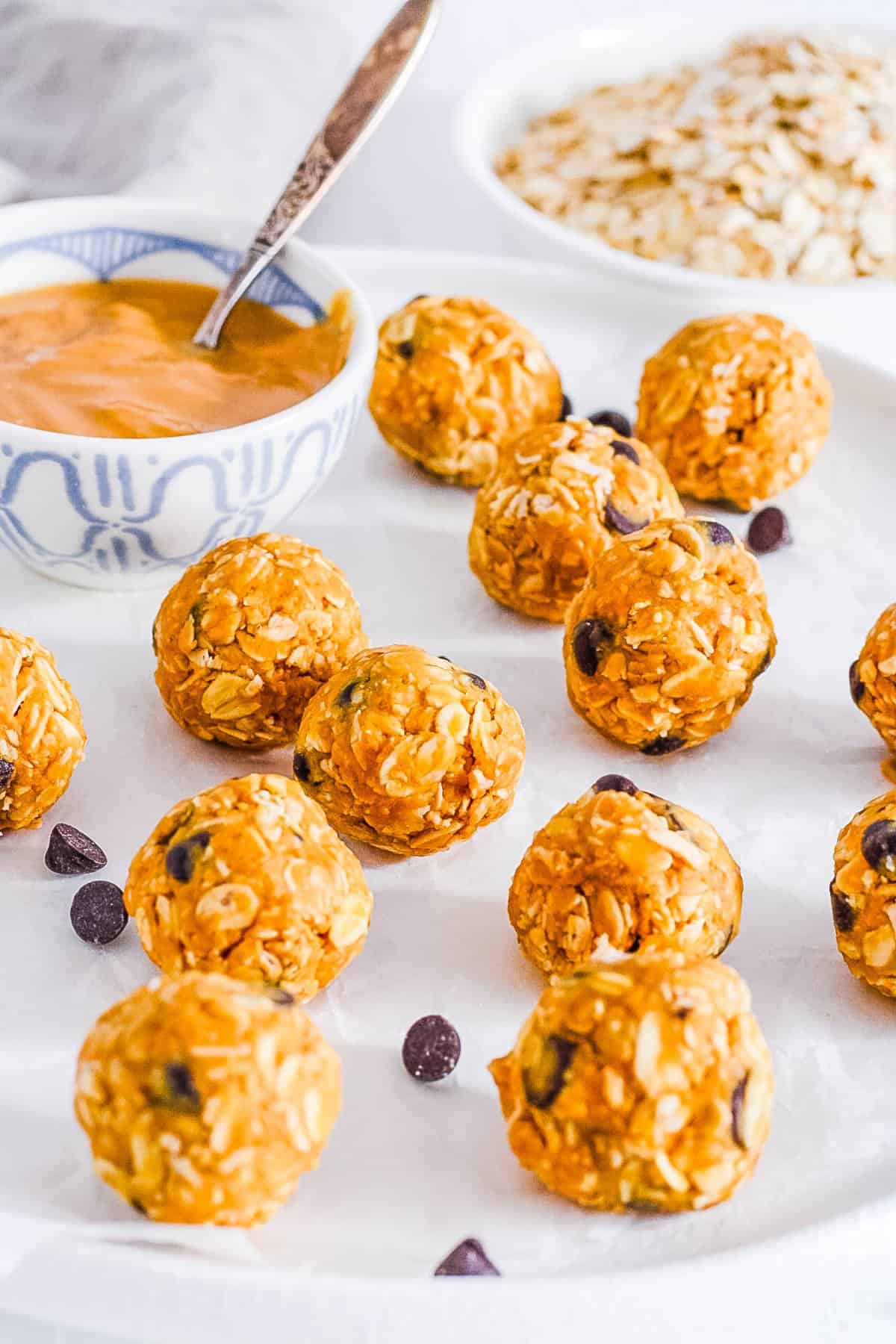
Indulge in my delicious no-bake peanut butter bliss balls, affectionately called “cookie dough bites” by my daughter. They taste like dessert, but are totally guilt-free and nutrient-rich! I love bliss ball recipes like this one because they come together quickly, and always satisfy my sweet tooth!
With only five simple ingredients and just ten minutes of prep time, bliss balls are a perfect option for busy days. I especially love making a huge batch at the beginning of the week, and enjoying them all week long for ultimate convenience. I find that they taste even better the next day, once they’ve had time to chill in the fridge for a while longer!
These protein balls with peanut butter are such a fun treat for any time of day! I really love how versatile they are – I’ll often use them as part of a quick breakfast, for packing in my kids’ lunches, or as a mid-afternoon snack.
Made with natural peanut butter, hearty oats, and a touch of pure maple syrup, I’ve crafted these bliss balls to be as healthy as possible. You won’t find any refined sugar here, even with these healthy swaps they still taste just like cookie dough. And each ball has only 90 calories and 3 grams of sugar!
I’ve also made sure that these wholesome ingredients can come together with minimal equipment required. No need to deal with your bulky food processor and spend all that extra time cleaning!
And my all time favorite thing about this recipe is that it’s a great way to involve kids in the kitchen. My kids have so much fun helping me out and adding in their own special twists.
Your family can also customize them in so many different ways, changing things up based on your preferences! I’ll share my favorite variations later in this post (like my peanut butter bliss balls with protein powder)!
Latest Recipe Video!
🥘 Ingredients
My easy peanut butter bliss balls recipe calls for just 5 nutritious ingredients, all easily found in your pantry or local grocery store. Here’s what you need:
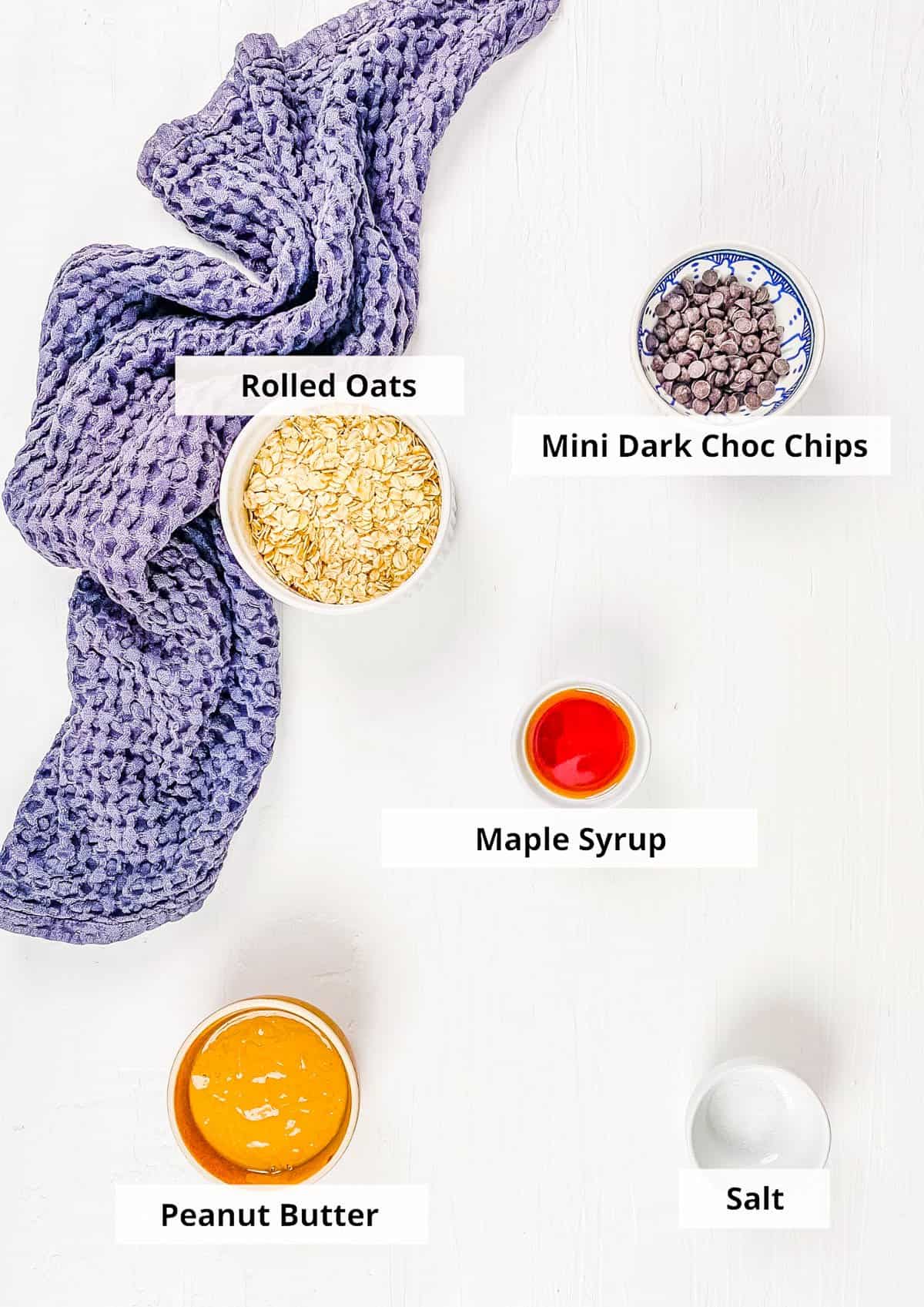
Oats: I’ve found that rolled oats work best for these kid-friendly bliss balls. I don’t recommend using oat flour or quick oats as it won’t have the same texture as whole oats, and won’t hold up as well.
Natural Peanut Butter: I use creamy peanut butter to bind all the ingredients together and add a boost of protein to these energy bites. If you don’t have peanut butter, try almond butter as a 1:1 substitute. Other nut butters (like cashew butter or a mixed nut butter) should also work in place of peanut butter, but the bites might have a slightly different consistency since some nuts create a thinner or runnier butter than others!
Dark Chocolate Chips: I prefer using dark chocolate chips for a healthier choice. These can be regular or mini chocolate chips. To keep this recipe vegan-friendly, I’ll use dairy-free chocolate chips. If you don’t need these to be vegan, then semisweet, white chocolate, or milk chocolate chips are all yummy options.
Maple Syrup: The only added sugar is natural maple syrup which gives the bliss balls a slightly sweet taste. If you don’t have maple syrup on hand, agave, raw honey, or vegan honey work.
Vanilla Extract: Pure vanilla extract brings out the richness of the chocolate. Sometimes I also add a pinch of salt to really enhance the sweetness. For a nutty flavor, try using almond extract.
🔪 How To Make Peanut Butter Bliss Balls
My vegan no bake peanut butter balls are so easy to make – they’re ready in just 3 simple steps. Let me show you how to make these healthy dessert balls:
Combine Ingredients: In a large bowl, using a wooden spoon, I start by stirring together the oats, peanut butter, chocolate chips, maple syrup, vanilla, and salt until combined.
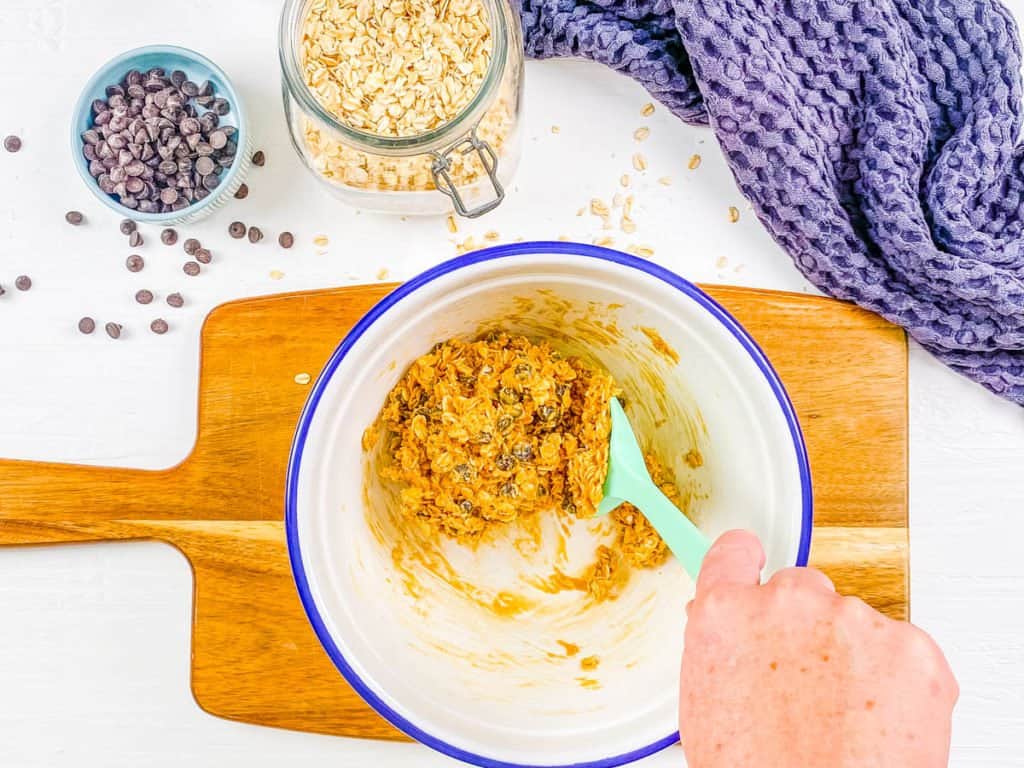
Form The Bliss Balls: Next, I line a baking sheet with parchment paper. Taking small handfuls of the mixture, I roll them into small balls 1-2 inches in size – about the size of a golf ball or ping pong ball. I prefer to use a cookie scoop to make this step extra easy. Place each ball onto the baking sheet.
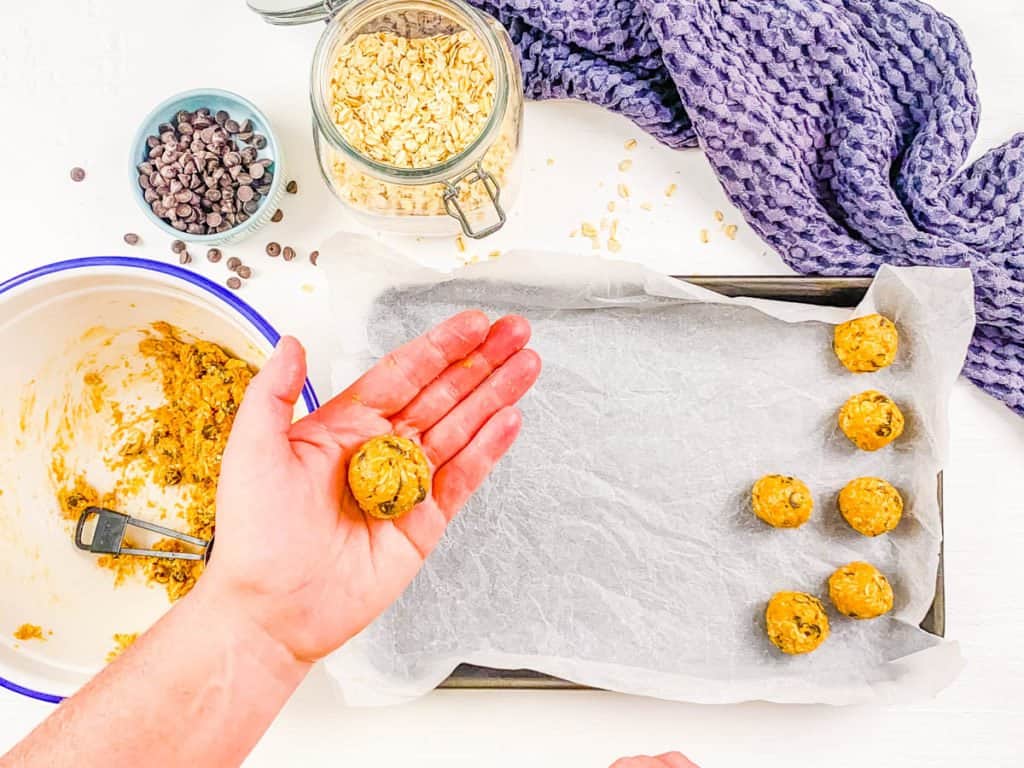
Let The Balls Set: Once rolled, I refrigerate these peanut butter snack balls for 30 minutes or until solid.
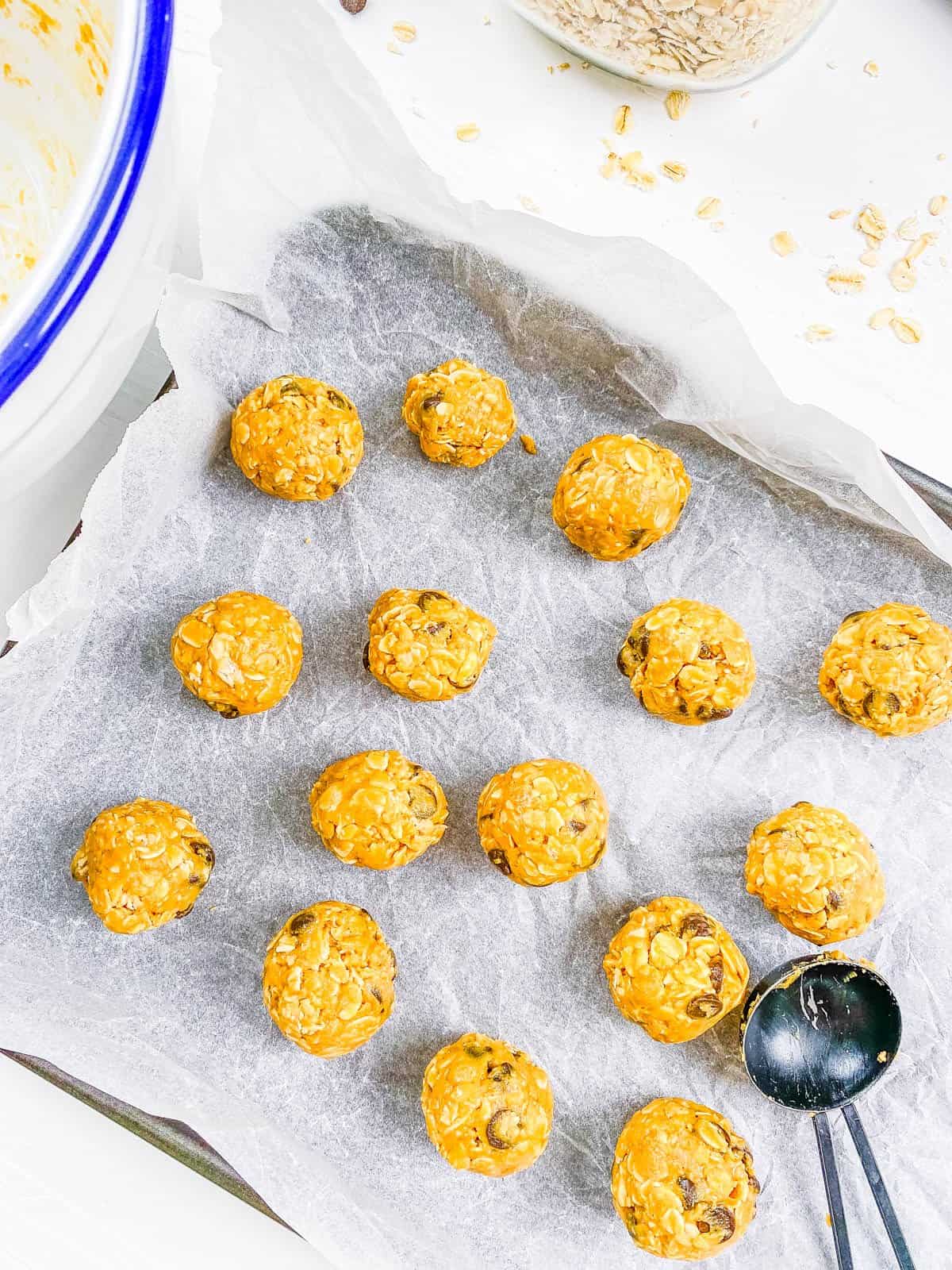
My #1 Secret Tip for this recipe is to make sure you measure ingredients precisely, with the right ratio of wet to dry ingredients.
While there is a little wiggle room with these bliss balls due to them being a no-bake recipe, I recommend being precise with all measurements to ensure ensures that the mixture has the right consistency to hold together without being too sticky or crumbly.
The creamy peanut butter is critical as the binding ingredient for these bliss balls, and I find it to be especially important to measure correctly. Too much or too little will throw the whole recipe off, leading to a mixture that is either too wet and sticky or too dry and crumbly.
After trial and error, I have found that achieving this balance is important for forming perfect bliss balls that stay intact and have a great texture.
Other Tips To Keep In Mind:
- Use The Right Tools: I like to use a cookie scoop to get all of these no-bake bliss balls the same size and to help my hands stay mess free!
- Check The Oats: If you or someone in your family is gluten intolerant, be sure to check the packaging on your oats for gluten-free certification. Some oats can be at risk for contamination with gluten substances.
- Involve The Kiddos: My kids love to help out in the kitchen, and this no-bake recipe is perfect for kids of all ages! They can learn how to measure out ingredients, combine ingredients, and roll the mixture into perfect ball shapes!
- Adjust For Moisture: If the dough seems too wet to mold into balls, consider adding a tablespoon or two of oat flour or almond flour. This will help to firm the mixture up so that it holds its shape and doesn’t stick to your hands.
- Bliss Balls For Kids: If you want to make these as toddler peanut butter balls I recommend reducing or omitting the sugar! You might also want to cut them into smaller bites when serving.
📖 Variations
I’ve perfected a few easy swaps and add-ins for when I’m looking to switch up the taste or texture a bit with these healthy kid-friendly bliss balls. There is something for any occasion! Here are my favorite variations:
Peanut Butter Protein Balls: If you want to turn these peanut butter protein bliss balls, consider adding a scoop of vegan vanilla protein powder to the batter before mixing it. You can use up to 2 scoops of protein powder, depending on the flavor of the protein powder you use. Sometimes I also add 1 tablespoon of ground chia seeds, flax seed, or hemp seeds for an extra boost of protein and healthy fats.
Chocolate Bliss Balls With Peanut Butter: For a double serving of chocolate, add a tablespoon of cacao or cocoa powder to the batter before mixing. I love the rich and indulgent flavor that this gives this recipe! I serve this as a healthy kids dessert often!
Peanut Butter Date Bliss Balls: For a sweeter flavor, I like to add a ¼ cup of Medjool dates, soaked and drained. I use a food processor when adding dates so that they are completely incorporated with the peanut butter and oats.
Sugar-Free Bliss Balls: If you want to make these no-bake peanut butter balls truly sugar-free, you can omit the maple syrup and use sugar-free chocolate. I think they still taste pretty good thanks to the natural sweetness from the vanilla and chocolate chips! If you are making these peanut butter balls for toddlers, this is a good option.
Mix-Ins: Add your favorite mix-ins to give these peanut butter energy balls some texture. I find that crushed walnuts, pecans, peanuts, sunflower seeds, and cacao nibs work really well in this recipe. My other favorites are dried fruit like cranberries, raisins, dried apricots, and shredded coconut. I also love adding spices like a pinch of sea salt, cinnamon powder, nutmeg, or pumpkin pie spice into the mixture. When making these as toddler protein balls, be mindful of the size of the nuts and dried fruit.
🍽 Serving Suggestions
While I love these healthy bliss balls with peanut butter on their own for an easy grab-and-go snack or healthy dessert, it can be so fun to get creative with other ways to serve these! Try some of these ideas:
Toppings: For a decadent dessert I love to drizzle chocolate sauce or caramel sauce (like the one on this no-bake salted caramel cheesecake) over these no bake snacks!
Ice Cream: My kids love to mix these no bake peanut butter dessert balls into tofu ice cream for a delicious treat.
Drinks: Energy balls can be found at a lot of coffee shops nowadays, so it only feels right to create those coffee shop vibes at home! I have been loving these balls with my oatmilk honey latte or iced ube latte! You can also do a creamy mixed berry smoothie alongside these protein balls for kids as an afternoon snack.
With Other Energy Bites: Make a spread of energy bites and serve these alongside my vegan protein balls, peanut butter date balls, and these homemade lara bars! I love this idea for parties and special occasions!
🫙 Storage Instructions
Room Temperature: I store these dairy free peanut butter balls in an airtight container at room temperature for up to 3 days.
To Refrigerate: After placing in an airtight container or resealable plastic bag, I’ll store these in the fridge for maximum freshness. They’ll be good for about one week!
Freezer: I don’t recommend storing these vegan energy balls in the freezer as they won’t taste as good when defrosted.
❓Recipe FAQs
The best type of peanut butter to use is natural peanut butter with no added sugars, oils, or preservatives. I recommend looking for a brand that has just one ingredient listed: peanuts. You can also use a brand that has peanuts and salt listed as the only two ingredients.
There are two ways I’d recommend adjusting this recipe if your mixture is too dry: 1) Add more peanut butter – it’ll help bind the ingredients and add moisture. 2) Add a little bit of coconut oil, maple syrup, or even a touch of applesauce – these ingredients will add moisture and flavor to your peanut butter oat balls!
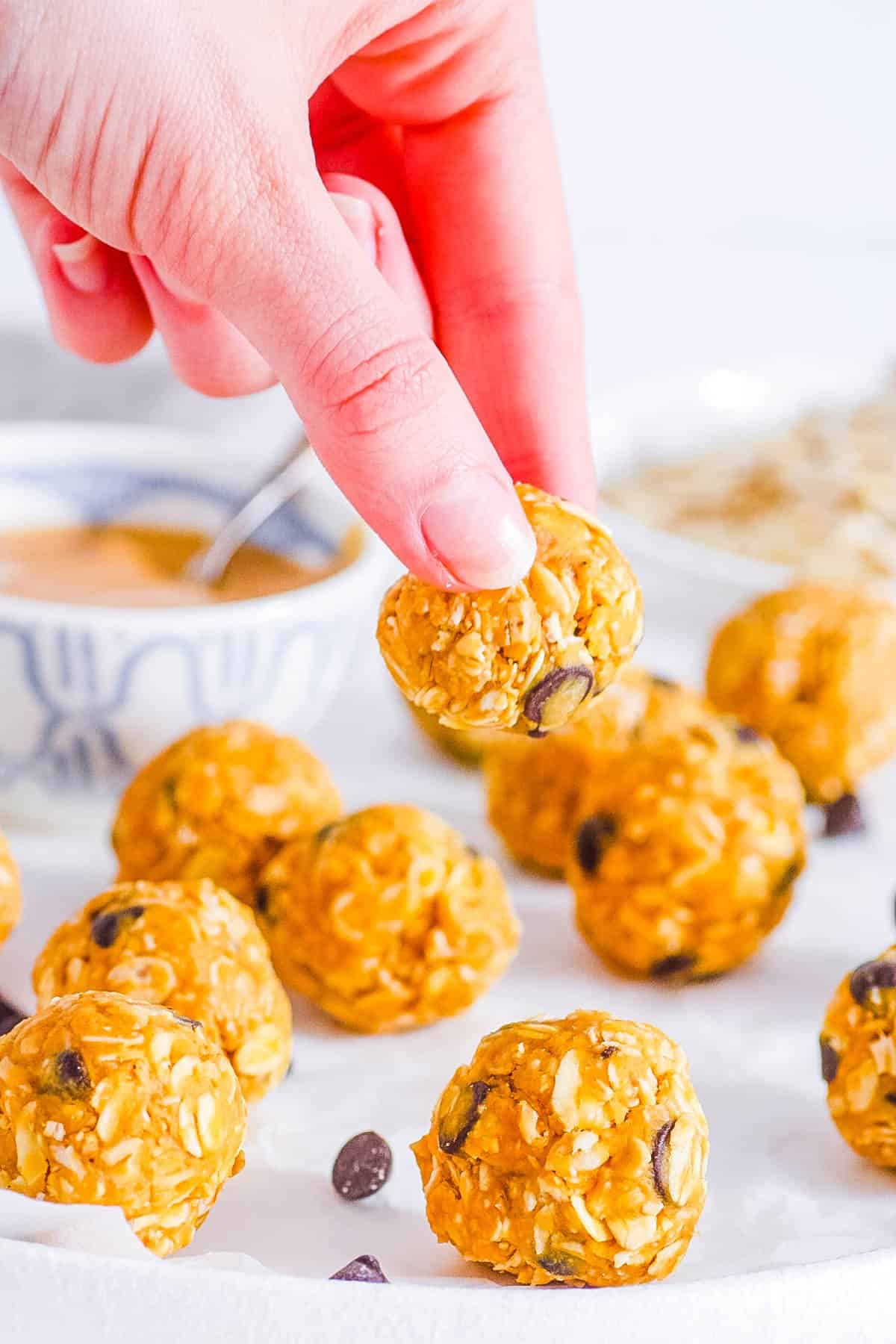
Want to Save This Recipe?
Enter your email & I’ll send it to your inbox. Plus, get great new recipes from me every week!
By submitting this form, you consent to receive emails from The Picky Eater.
Love this plant based dessert recipe? Please leave a 5-star rating 🌟 in the recipe below and/or a review in the comments section further down the page!
You can also FOLLOW ME on FACEBOOK, INSTAGRAM, and PINTEREST to see more delicious, healthy, family-friendly food, and if you have any questions, I’m here to help!
📋 Recipe Card
Healthy No-Bake Peanut Butter Bliss Balls
My healthy, easy no bake peanut butter bliss balls are loaded with creamy peanut butter and chocolate flavor, making them a hit with both kids and adults alike. Enjoy these as an on-the-go breakfast, wholesome snack, or healthy dessert alternative! They’re also dairy-free, vegan, gluten-free, and low in sugar, making them ideal for a variety of dietary preferences.
Servings: 16 balls
Calories: 93kcal
-
In a large bowl, using a wooden spoon, stir together the oats, peanut butter, chocolate chips, maple syrup, vanilla, salt (and protein powder, if using) until combined.
-
Line a baking sheet with parchment paper.
-
Taking small handfuls of the mixture, roll them into small balls 1-2 inches in size. Or you can use a cookie scoop. Place them onto the baking sheet.
-
Refrigerate the bites for 30 minutes or until solid. Store in an air-tight container in the fridge (they will last at least 1 week, and likely 2!)
- Use The Right Tools: Use a cookie scoop to get all of the balls the same size.
- Check The Oats: If you or someone in your family is gluten intolerant, be sure to use gluten-free oats.
- Involve The Kiddos: This is such a great no bake recipe for kids to make – get them in the kitchen!
- Adjust For Moisture: If the dough seems too wet to mold into balls, consider adding a tablespoon or two of almond flour.
- Sugar Free: If you want to make these truly sugar-free, you can omit the maple syrup, and they will still taste pretty good.
- Peanut-Free: Use your favorite alternative nut butter or seed-based butter.
- Nutritional information includes protein powder. Note: for even more protein, use 1 scoop of vegan vanilla protein powder and 1 scoop of peanut butter protein powder.
Serving: 1ball | Calories: 93kcal | Carbohydrates: 8g | Protein: 4g | Fat: 5g | Saturated Fat: 2g | Polyunsaturated Fat: 1g | Monounsaturated Fat: 2g | Cholesterol: 4mg | Sodium: 43mg | Potassium: 92mg | Fiber: 1g | Sugar: 3g
Health
Federal Experts Talk Bird Flu ‘What Ifs’ in WebMD Live Event

May 16, 2024 – Multiple U.S. agencies are working to contain the recent bird flu outbreak among cattle to prevent further spread to humans (beyond one case reported in early April) and use what we learned before, during, and after the COVID-19 pandemic to keep farm workers and the general public safe.
Fingers crossed, the bird flu will be contained and peter out. Or the outbreak could continue to spread among dairy cattle and other animals, threatening the health and livelihoods of farmers and others who work with livestock.
Or the virus could change in a way that makes it easier to infect and spread among people. If this happens, the worst-case scenario could be a new influenza pandemic.
With so many unknowns, WebMD brought together experts from four federal agencies to talk prevention, monitoring, and what the “what ifs” of bird flu might look like.
Communication with the public “about what we know, what we don’t know, and ways you and your family can stay safe is a priority for us at CDC,” said Nirav D. Shah, MD, JD, the CDC’s principal deputy director. “We at the federal level are responding, and we want the public to be following along.”
People should consult the websites for the CDC, FDA, U.S. Department of Agriculture (USDA), and the Administration for Strategic Preparedness and Response (ASPR) for updates.
It is essential to not only stay informed, but to seek trusted sources of information, Shah said during “Bird Flu 2024 – What You Need to Know,” an online briefing jointly sponsored by the CDC and WebMD.
An ‘Experimental Hamburger’
If one take-home message emerged from the event, it was that the threat to the general public remains low.
The retail milk supply is safe, although consuming raw or unpasteurized milk is not recommended. “While commercial milk supply is safe, we strongly advise against drinking raw milk,” said Donald A. Prater, DVM, acting director for the FDA’s Center for Food Safety and Applied Nutrition.
As for other foods, thoroughly cooked eggs are less risky than raw eggs, and the nation’s beef supply remains free of the virus as well.
For years, federal inspectors have purchased and tested meat at retail stores, said Eric Deeble, DVM, USDA deputy assistant secretary for the Office of Congressional Relations. So far, H5N1, the virus behind bird flu, has not been detected in beef.
The USDA took testing a step further and recently cooked ground beef from dairy cows in their lab. Using what Deeble described as an “experimental hamburger,” the agency showed cooking beef to 165 F or higher kills the virus if it ever becomes necessary.
The federal government now requires all cattle be tested and be free of bird flu virus before crossing any state lines. The government is also reimbursing farmers for veterinary care and loss of business related to the outbreak, and supply personal protective equipment (PPE) like gloves, masks, and face shields to workers.
Vaccination Not Recommended Now
Federal scientists know enough about H5N1 virus to create vaccines against it quickly if the need arises. It’s more about planning ahead at this point. “Vaccines are not part of our response right now,” said David Boucher, PhD, director of infectious diseases preparedness and response at the Administration for Strategic Preparedness and Response.
If the virus changes and becomes a bigger threat to people, “we have the building blocks to produce a vaccine,” Boucher added.
An event attendee asked if the seasonal flu shot offers any protection. “Unfortunately, the flu shot you got last year does not provide great protection from the avian flu,” Shah responded. “It might do a little bit … but that is the vaccine for seasonal flu. This is something more novel.”
Treatments Stockpiled and Ready
Antiviral medications, which if given early in the course of bird flu infection could shorten the severity or duration of illness, are available now, Shah said. The dairy farmer who was infected with bird flu earlier this year responded to oseltamivir (Tamiflu) treatment, for example.
When it comes to bird flu symptoms, the fact that the only infected person reported so far this year developed pink eye, also known as conjunctivitis, is interesting, Shah said. Officials would have expected to see more typical seasonal flu symptoms, he added.
“Influenza is not a new virus,” Boucher said. “With this strain of influenza, we are not seeing any genetic markers associated with resistance to antivirals. That means the antivirals we take for seasonal influenza would also be available if needed to treat H5N1.”
ASPR has stockpiled Tamiflu and three other antivirals. “We do have tens of millions of courses that can be distributed around the country if we need them,” he added.
“Influenza is an enemy we know well,” Boucher said. That is why “we have antivirals ready to go now and many types of PPE.”
Science in Action
The feds intend to stay on the case. They will continue to monitor emergency department visits, lab test orders, and wastewater samples for any changes suggesting a human pandemic risk is growing.
“While we’ve learned a great deal, there are still many things we do not know,” Deeble said.
Shah added, “As in any outbreak, this is an evolving situation and things can change. What you are seeing now is science in action.”
For the latest updates on bird flu in the United States, visit the CDC’s H5N1 Bird Flu: Current Situation Summary website.
-

 African History4 months ago
African History4 months agoBlack History Facts I had to Learn on My Own pt.6 📜
-

 African History4 years ago
African History4 years agoA Closer Look: Afro-Mexicans 🇲🇽
-

 African History1 year ago
African History1 year agoPROOF AFRICAN AMERICANS AIN'T FROM AFRICA DOCUMENTED EVIDENCE
-

 African History2 years ago
African History2 years agoHow Did Normal Medieval People Survive Winter? | Tudor Monastery Farm | Chronicle
-

 African History4 years ago
African History4 years agoA Closer Look: Afro-Mexicans 🇲🇽
-

 African History3 years ago
African History3 years agoWhat happened to the many African Kingdoms? History of Africa 1500-1800 Documentary 1/6
-

 African History3 years ago
African History3 years agoThe Entire History of Africa in Under 10 Minutes – Documentary
-

 African History2 years ago
African History2 years agoAFRO MEXICO: Black History In Mexico!

